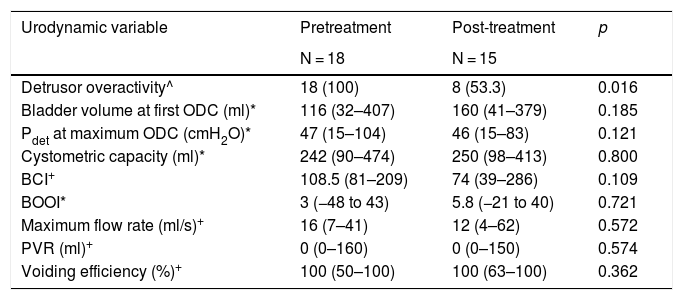The use of onabotulinumtoxin A (BoNT-A) injection in male patients with detrusor overactivity (DO) after stress urinary incontinence (SUI) surgery has been scarcely described. Our aim was to assess results of this treatment in this specific population.
Materials and methodsRetrospective analysis of men with previous SUI surgery who had been treated with a first injection of 100 U BoNT-A because of DO since 2010 in our department. Treatment response was assessed with the Treatment Benefit Scale: 1) greatly improved; 2) improved; 3) not changed; 4) worsened after treatment (Treatment Benefit Scale 1 or 2: treatment response). Complications were classified according to the Clavien-Dindo classification. Treatment continuation was considered present if, at the last visit, patients had received a BoNT-A injection within the preceding 12 months. Pre- and post-treatment urodynamic variables were compared.
ResultsEighteen patients were included, median age 71.1 (59.1–83.5) years. Twelve (66.7%) patients reported response to treatment. Two (11.1%) complications were detected: urinary retention requiring clean intermittent catheterization (Clavien-Dindo 2). No complications related to previous SUI surgery were detected. Fifteen (83.3%) patients had a follow-up >12 months (median follow-up 57 [15–89] months) and all of them had discontinued treatment at the end of follow-up. Urodynamic studies showed significant improvement in terms of DO and bladder compliance.
ConclusionAlthough most men with DO after SUI surgery respond to intradetrusor BoNT-A injection, all of them discontinue treatment due to personal reasons. It is a safe procedure, with urinary retention requiring clean intermittent catheterization being the most frequent complication.
El uso de la inyección de onabotulinumtoxin A (BoNT-A) en pacientes masculinos con hiperactividad del detrusor (HD) tras la cirugía para la incontinencia urinaria de esfuerzo (IUE) ha sido escasamente descrito. Nuestro objetivo fue evaluar los resultados de este tratamiento en esta población específica.
Materiales y métodosAnálisis retrospectivo desde 2010 en pacientes varones que reciben una primera inyección de 100 U de BoNT-A para el tratamiento de HD tras someterse a una cirugía previa para la IUE en nuestro departamento. La respuesta al tratamiento se valoró mediante la Escala de Beneficio del Tratamiento: 1) mejoría significativa; 2) mejoría; 3) sin cambios; 4) empeoramiento tras el tratamiento (Escala de Beneficio del Tratamiento 1 o 2: respuesta al tratamiento). Las complicaciones se catalogaron según la clasificación de Clavien-Dindo. Se consideró la continuación del tratamiento si los pacientes habían recibido una inyección de BoNT-A durante los 12 meses previos a la última revisión. Se compararon las variables urodinámicas antes y después del tratamiento.
ResultadosSe incluyeron 18 pacientes, con una edad mediana de 71,1 (59,1–83,5) años. Doce (66,7%) pacientes refirieron respuesta al tratamiento. Se detectaron 2 (11,1%) complicaciones: retención urinaria que requirió cateterismo intermitente limpio (Clavien-Dindo 2). No se detectaron complicaciones relacionadas con la cirugía previa para la IUE. Quince (83,3%) pacientes recibieron un seguimiento >12 meses (mediana de seguimiento 57 [15–89] meses) y todos habían suspendido el tratamiento al final del seguimiento. Se observó una mejoría significativa en la presencia de HD y en la acomodación vesical en el estudio urodinámico.
ConclusiónAunque la mayoría de los hombres con HD después de la cirugía de IUE responden a la inyección intradetrusor de BoNT-A, todos interrumpen el tratamiento por motivos personales. Se trata de un procedimiento seguro, cuya complicación más frecuente es la retención urinaria que requiere cateterismo intermitente limpio.









